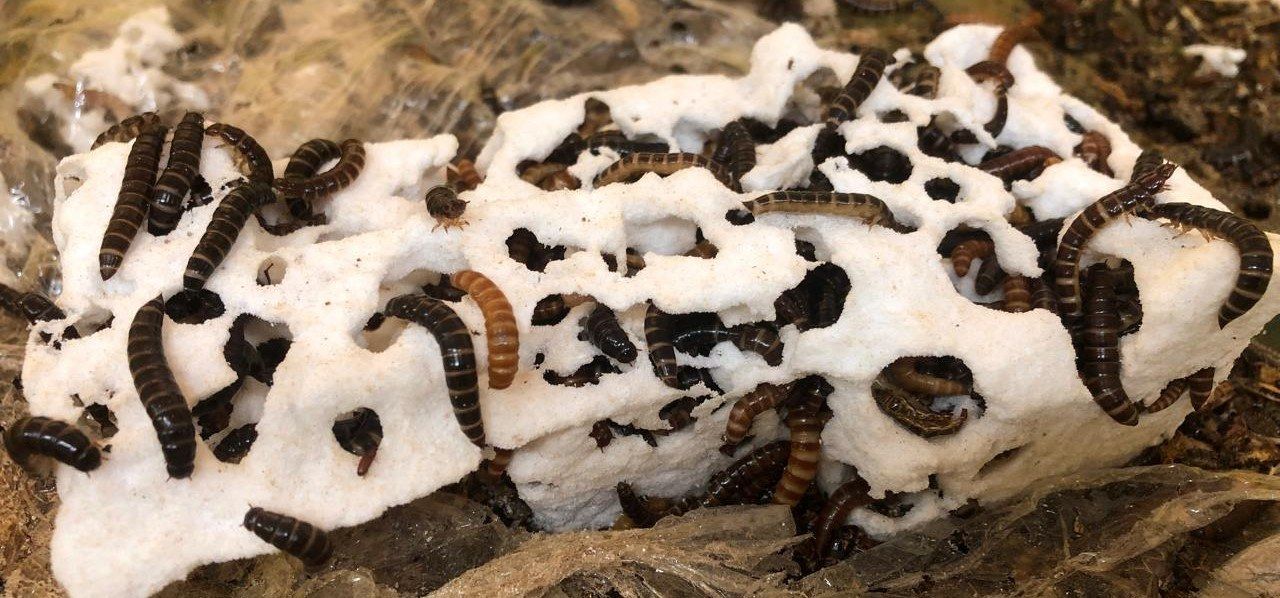Lesser Mealworms: Tiny insects with potential to tackle the plastic problem
The dark lesser mealworm, native to Africa, has shown a surprising ability to consume polystyrene, one of the most common plastic pollutants. Scientists are investigating how these insects and their gut bacteria break down plastic, offering a potential breakthrough in sustainable waste management.

Dark lesser mealworms feeding on polystyrene foam. Image: © International Centre of Insect Physiology and Ecology
Classification
- Kingdom
- Animalia
- Phylum
- Arthropoda
- Class
- Insecta
- Order
- Coleoptera
- Family
- Tenebrionidae
- Genus
- Alphitobius
- Species
Globally, more than 400 million tons of plastic are produced annually but less than 10% is recycled with an estimated 19–23 million tons ending up in water bodies. Plastic waste may contain toxic chemicals that pollute water, degrade soil quality, disrupt ecosystems, and hinder essential processes like nutrient cycling, soil formation, and erosion control. These chemicals can also reduce biodiversity and eventually enter the food chain. Plastic pollution is a global problem as it takes many years for plastics to degrade naturally. Furthermore, plastic waste often breaks down into tiny particles called microplastics, which can harm wildlife and enter the food chain. The discovery that the African dark lesser mealworm (Alphitobius sp.) can consume plastic opens up exciting possibilities for innovative plastic waste management solutions.
The dark lesser mealworm
The dark lesser mealworm is the larval stage of a darkling beetle species endemic to Kenya. It is commonly found in poultry farms and chicken coops and is considered a storage pest as it feeds on grains and organic waste. However, some yellow mealworm species (like Tenebrio molitor) have also been shown to consume plastics.
The Researchers at the International Centre of Insect Physiology and Ecology (icipe) recently discovered that the dark lesser mealworm, can consume polystyrene – one of the most prevalent types of plastic, that is accumulating rapidly in both land and water environments.
Footage of dark lesser mealworms eating plastic. Video: © International Centre of Insect Physiology and Ecology
Digesting polystyrene is impossible for most living organisms. However, the dark lesser mealworm appears to have secret allies: its gut microbiome. It comprises of microorganisms, like bacteria, that assist in the breakdown of food. Researchers at icipe found that dark lesser mealworms can survive on a diet of polystyrene alone for weeks, although they still prefer their natural diet (wheat bran and organic waste). As the mealworms consume polystyrene, their gut bacteria may play a role in breaking it down into smaller compounds that may be safely excreted. The first stage of research has confirmed that the dark lesser mealworm can consume polystyrene and has also provided evidence that its gut microbiome contains bacteria such as Kluyvera, Klebsiella, and Lactococcus – genera previously associated with polystyrene degradation. Further studies are underway to determine the extent to which the gut microbiome plays a role in the digestion or degradation of this plastic, the bacteria species involved, the enzymes responsible for the degradation process and the safety of the resulting compounds.
To view this content, you must accept marketing and third-party cookies.
Did you know?
Some DIY projects can be found here.
Potential applications
Polystyrene waste primarily originates from its most common commercial form, polystyrene foam. This material is widely used in food storage containers, packaging, and insulation in construction. Existing polystyrene recycling methods, including chemical, thermal, and mechanical methods, are expensive, and generate toxic compounds that are harmful to humans, the environment, and biodiversity. Therefore, application of lesser mealworms in sustainable waste management is desirable and may potentially include:
- Biodegradation solutions – Identifying and mass-producing the enzymes that break down plastic could lead to treatments that efficiently degrade plastic waste in landfills.
- Plastic recycling improvements – Using plastic-degrading enzymes or bacteria such as bacterial species in the genera Kluyvera, Klebsiella, Lactococcus and Citrobacter, could make recycling more efficient and cost-effective than traditional methods.
- Sustainable waste management – Once identified, these bacteria can be rapidly cultured, or their polystyrene-degrading enzymes synthesized on an industrial scale. Industries dealing with plastic waste could then use them to help break down polystyrene.
Challenges and considerations
While the ability of lesser mealworms to consume polystyrene is promising, several challenges must be overcome before it can be applied on a large scale. Firstly, a single mealworm can only consume a small amount of plastic at a time (50 larvae can consume approximately 0.4 grams of polystyrene in 30 days). To make a real impact, we need efficient ways to scale up this process. Furthermore, releasing mealworms into the wild to consume plastic could have unintended consequences, such as disrupting local ecosystems. To avoid these risks, research is focusing on isolating the consortia* of bacteria and/or the enzymes responsible for plastic degradation. This approach offers a safer and more controlled alternative to using live insects.
The future of plastic-eating insects
The lesser mealworm’s ability to consume plastic highlights how nature can provide solutions to human-made environmental problems. By studying and applying these biological processes, scientists may identify innovative solutions to reduce the global impact of plastic waste. While the dark lesser mealworms alone may not solve the plastic pollution crisis, in addition to other insect species with plastic consuming abilities such as the yellow mealworm (Tenebrio molitor), the Indian meal moth (Corcyra cephalonica), the lesser wax moth (Achroia grisella), the greater wax moth (Galleria mellonella) and super worms (Zophobas morio), they provide a good starting point for developing more efficient waste management systems.
*Glossary
Consortia of bacteria: Two or more bacterial or microbial groups living symbiotically.
References
Can the mealworm be the answer to Africa’s plastic waste problem? https://www.icipe.org/news/can-mealworm-be-answer-africa%E2%80%99s-plastic-waste-problem.
Ndotono, E.W., Tanga, C.M., Kelemu, S. et al. Mitogenomic profiling and gut microbial analysis of the newly identified polystyrene-consuming lesser mealworm in Kenya. Sci Rep 14, 21370 (2024). https://doi.org/10.1038/s41598-024-72201-9
